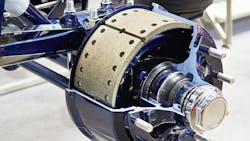Key takeaways:
- CVSA announced the results of its unannounced brake safety inspection day from April 22.
- Participating jurisdictions performed 4,569 inspections, focusing on commercial vehicle brake systems.
- Of the inspected vehicles, 398 (8.7%) were placed out of service for brake violations.
The Commercial Vehicle Safety Alliance announced the results of its unannounced brake safety inspection day: On April 22, CVSA placed 398 commercial motor vehicles out of service for brake violations in the U.S. and Canada.
During the unannounced brake safety event, inspectors in 45 jurisdictions throughout Canada, Mexico, and the U.S. conducted 4,569 commercial motor vehicle inspections, placing 8.7% of those vehicles out of service for brake-related violations. Meanwhile, 91.3% did not have any brake-related out-of-service violations.
CVSA’s Brake Safety Day is an unannounced brake-safety inspection and regulatory compliance enforcement initiative, whereby certified commercial motor vehicle inspectors conduct routine roadside inspections focusing on brake systems and components, and provide CVSA with brake-related inspection and violation data.
See also: Cargo theft’s new normal: How we got here and how to protect your fleet
This year, emphasis was placed on vehicles’ drums and rotors. Thirty-two (8%) commercial motor vehicles had drum/rotor violations during the one-day event. Fourteen of those violations resulted in the vehicle or combination being placed out of service.
Previous Brake Safety Day results
- 2024: 4,898 inspections, 570 (11.6%) placed OOS
- 2023: 6,829 inspections, 773 (11.3%) placed OOS
- 2022: 9,132 inspections, 1,290 (14.1%) placed OOS
- 2021: 10,091 inspecitons, 1,273 (12.6%) placed OOS
Brake drum and rotor issues may affect a commercial motor vehicle’s brake efficiency and result in violations or out-of-service conditions that may affect a motor carrier’s safety rating. Furthermore, broken pieces of drums or rotors may become dislodged en route and damage other vehicles or result in injuries or fatalities.
Inspectors identified 237 (59.5%) commercial motor vehicles that met the 20% defective brakes criterion, which is when 20% or more of the vehicle’s (or combination of vehicles’) brakes have an out-of-service condition.
In addition, inspectors identified 77 out-of-service violations related to brake hoses and/or tubing, 48 vehicles had steering axle out-of-service violations, 38 vehicles failed an air loss rate test, and there were 112 other out-of-service brake violations, such as worn brake lines/hoses, inoperative tractor protection system, inoperative low-air warning device, air leaks, hydraulic fluid leaks, etc.
Also, nine U.S. jurisdictions utilized a performance-based brake tester (PBBT) on Brake Safety Day and conducted 100 PBBT Inspections. A PBBT is a machine that assesses the braking performance of a vehicle. U.S. Federal Motor Carrier Safety Regulations and CVSA’s North American Standard Out-of-Service Criteria require a minimum braking efficiency of 43.5%. Eight (8%) vehicles failed to meet the required 43.5% minimum braking efficiency rate and were placed out of service.
CVSA’s unannounced Brake Safety Day is part of Operation Airbrake, a CVSA program dedicated to improving commercial motor vehicle brake safety throughout North America. CVSA’s seven-day Brake Safety Week, another Operation Airbrake campaign, is scheduled for Aug. 24-30.
About the Author
Jeremy Wolfe
Editor
Editor Jeremy Wolfe joined the FleetOwner team in February 2024. He graduated from the University of Wisconsin-Stevens Point with majors in English and Philosophy. He previously served as Editor for Endeavor Business Media's Water Group publications.

